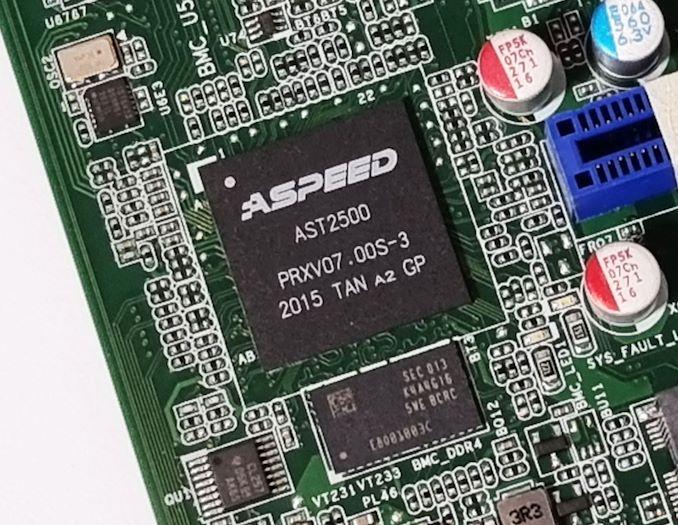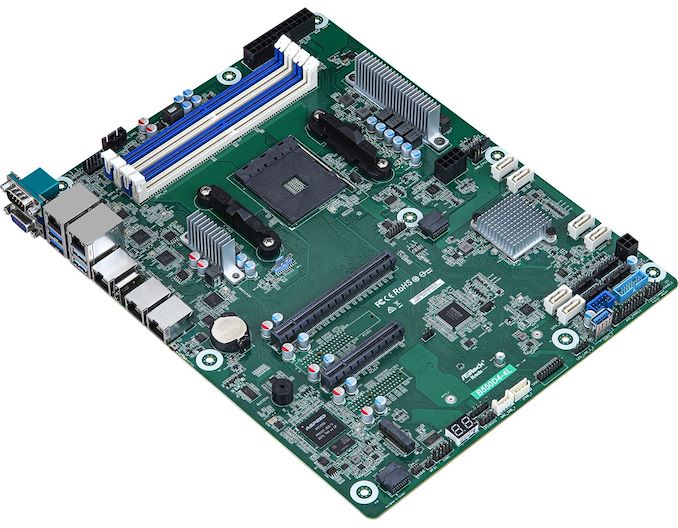ASRock Rack B550D4-4L Motherboard Review: B550 Goes Professional with BMC
by Gavin Bonshor on May 20, 2021 9:00 AM ESTConclusion
Not every motherboard is created equally, nor is every motherboard created with the same functionality as other models. Typically as seen on Intel platforms, it has its consumer-level chipsets such as B560, Z590, Z490, etc, but it also has a level pegged W480 chipset for professional users, which falls outside of its typical industrial level Xeon Scalable platform. Looking at AMD, it doesn't really do this with its desktop platforms, and users looking for workstation-level performance with consumer-level functionality can opt for Threadripper. The other options include Ryzen for desktop, and EPYC for enterprise, cloud, and server, with no real in-between.
When we first got wind of the ASRock Rack B550D4-4L back in January, it piqued our interest as it's the only known board to us that uses AMD's B550 desktop chipset to feature a BMC controller, in this case, an ASPEED AST2500, which is commonly used on professional level boards such as this. Another unique feature of the B550D4-4L is that it has four Intel Gigabit Ethernet ports on the rear, with a fifth designed to provide users access to the board's IPMI, for remote access purposes.
Being on an AMD Ryzen desktop platform, this allows users to use PCIe 4.0, with one full-length PCIe 4.0 x16 slot, and one half-length PCIe 4.0 x4 slot. Typically B550 boards only have one PCIe 4.0 slot, and this is where the B550D4-4L opts for a second PCIe 4.0 slot over a Gen 4 M.2 slot. Instead, the board has one PCIe 3.0 x4 M.2 slot, which supports SATA. As we know, the B550 chipset itself uses PCIe 3.0 lanes, and ASRock Rack is routing this through AMD's modular chipset and tracing to add the second PCIe 4.0 x4 half-length slot. Other storage options include six SATA ports, with four from the chipset with RAID 0, 1, and 10 support, and two via an ASMedia ASM1061 SATA controller.
Functionality and usability are two key parameters to look for in a server-focused model, and the B550D4-4L provides plenty of this, with an intuitive and accessible IMPI interface. We've highlighted that the ASRock Rack IPMI is functional in previous reviews, and the B550D4-4L is no different in this regard. There is also plenty of functionality within the firmware, with B550 specific options including access to AMD Ryzen's Precision Boost Overdrive settings, as well as an LN2 mode, which seems completely out of tune with the board's core values. We really wouldn't recommend overclocking a Ryzen 3000 or 5000 series desktop processor on this board, primarily due to the design of the 4+2 power delivery, and the inadequate heatsinks designed to cool it.

The ASPEED AST2500 BMC chip on the ASRock Rack B550D4-4L motherboard
Focusing on the performance, and the B550D4-4L was surprisingly competitive when compared to other B550 models, not just in our system testing, but in our computational benchmarks too. It has Precision Boot Overdrive (PBO) applied by default, which allowed our Ryzen 7 3700X processor to stretch its legs a little, especially when cooled with our Corsair H150i Elite Capellix 360 mm AIO cooler. The only negative in performance came in our DPC latency testing, with our results showing that this board isn't suitable for DAW systems. In the firmware, we did try setting the same settings as other B550 models on test, but no matter what we inputted in relation to memory settings, the latencies wouldn't change on our memory and resulted in DDR4-3200 with CL22 latencies; this would have a negative impact on general compute performance, but with DDR4-3200 CL16, we would expect it to be highly competitive with other models we've tested.
Final Thoughts
The ASRock Rack B550D4-4L at the time of writing is in a league of its own, with no other AMD B550 series motherboards offering a BMC controller. Another factor to consider here is we haven't been able to find this model anywhere at retail, and we don't have any official MSRP pricing at this time. This makes it tricky, to sum up as it's hard to recommend a model we can't physically get our hands on globally. We do expect the B550D4-4L to be available at retail at some point, and when it eventually is, it offers an interesting professional-level take on AMD's consumer B550 platform.
It keeps up with other B550 in terms of performance which is surprising, but it also has an excellent IPMI interface for easy access and usability. This makes the B550D4-4L one of the most interesting B550 models we've seen so far, especially with four Gigabit Ethernet ports.











73 Comments
View All Comments
bill.rookard - Thursday, May 20, 2021 - link
Well that all should mean that (for example) if the board supported my Ryzen 1700, that it also would allow for ECC RAM? I know it doesn't support the 1700, curious to see if it would support my Ryzen 1600 (AF stepping)mode_13h - Friday, May 21, 2021 - link
> curious to see if it would support my Ryzen 1600 (AF stepping)No way. I can already guess it won't support anything older than Ryzen 3000-series, but the CPU-support list is here:
https://www.asrockrack.com/general/productdetail.a...
domboy - Thursday, May 20, 2021 - link
I don't understand why more motherboards don't have the memory slots setup this way. Most cases I see for sale have airflow from front to rear so would benefit a memory slot setup like this board has. Maybe I'm missing something...Linustechtips12#6900xt - Thursday, May 20, 2021 - link
I dot know tons of stuff about servers but why arent there basically any VRM heatsink? just not nessacary because of no oc? but wouldn't you want better power delivery and in return, lower VRM temps for stability anyway?bill.rookard - Thursday, May 20, 2021 - link
Not necessary really. IIRC they're rated at a pretty high temp usually (100+C) and as long as they have some airflow they're fine and usually servers have some pretty good sideways airflow going on. If you're going to OC - then yes you're going to run the VRMs hard and should have a heatsink, but in this application there's no OC facility.TheinsanegamerN - Thursday, May 20, 2021 - link
No OC is most of it. When running within their power limts Ryzen chips are very efficient, and the VRMs are jsut not going to get that hot. Even boards with sub par VRMs only put out 4-5 watts of heat at full load with a 95 watt CPU.Given these boards are usually put into either server style chassis with tons of airflow or have top down coolers that will blow onto the VRMs temps should be fine.
mode_13h - Friday, May 21, 2021 - link
I see a heatsink both in front and in back of the CPU socket. What are those, then?Linustechtips12#6900xt - Monday, May 24, 2021 - link
yes, but they are basically nothing that's why I said "but why aren't there basically any VRM heatsink?" not why arent there VRM heatsink/Heatsinks.docbones - Thursday, May 20, 2021 - link
Weird board. Would have also expected 10gb ethernet and also many more Sata ports.Cooe - Thursday, May 20, 2021 - link
"Users with Ryzen desktop processors can only use non-ECC DDR4, while users with Ryzen Pro models with Radeon Graphics and PRO technologies can use ECC memory."Uhh.. ECC memory works just fine with bog standard (aka "not Pro") Ryzen CPU's and has LITERALLY since their launch in 2017.